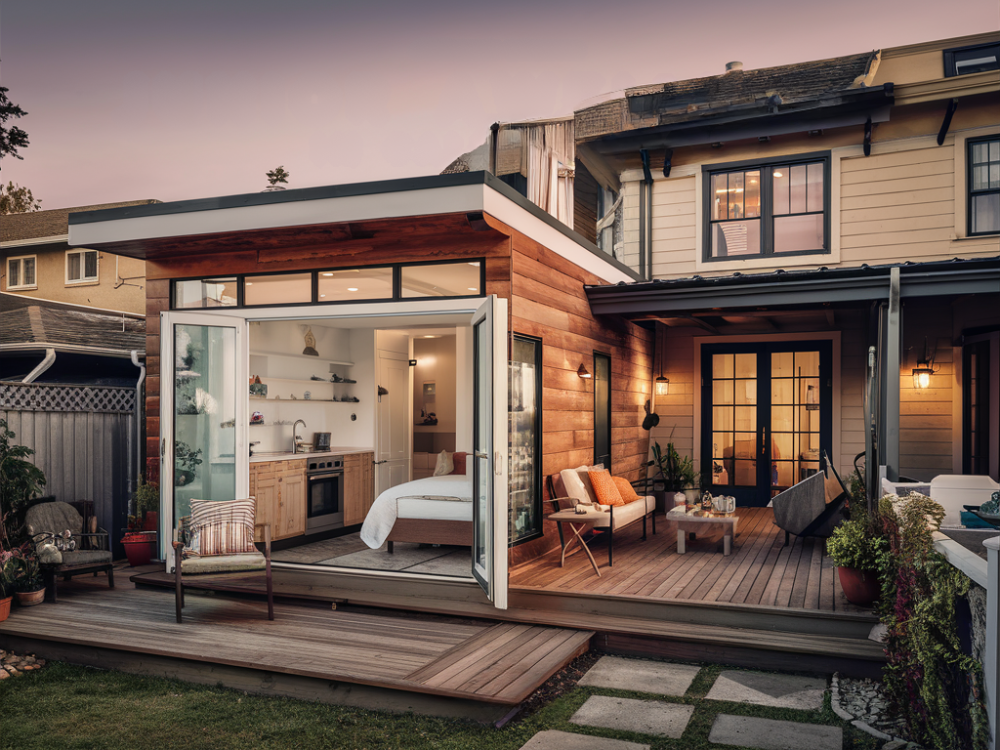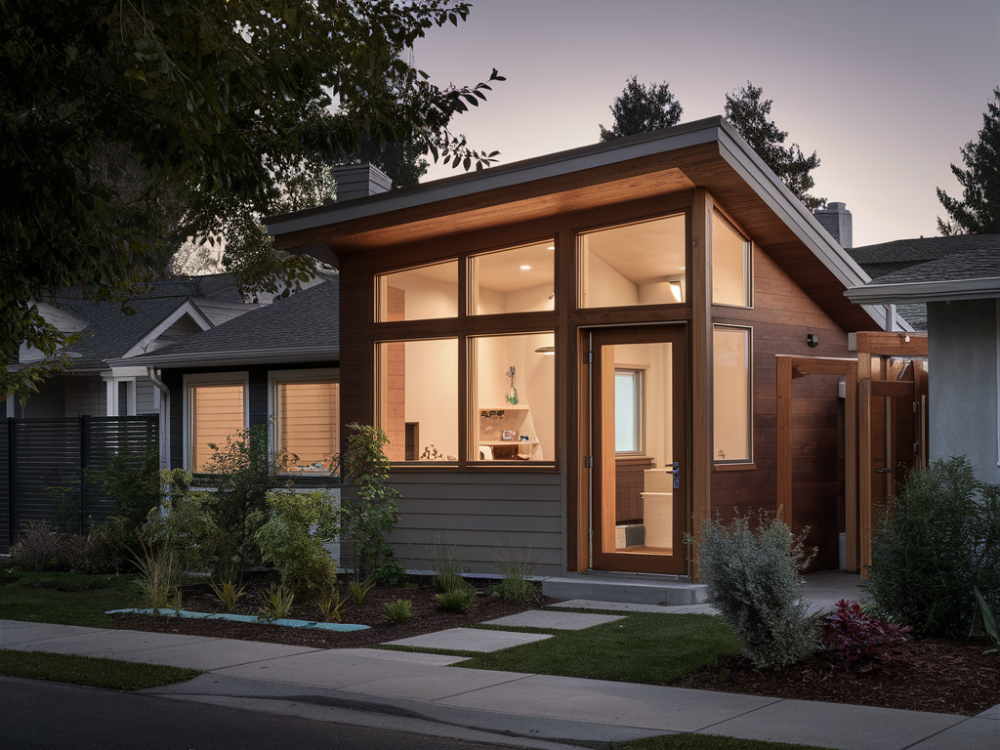Junior Accessory Dwelling Units (JADUs) are a unique way to transform part of your home into a self-sufficient living space.
According to California rules, these units are required to be less than 500 square feet and must be contained within the walls of a single-family residence. These small units also have their own entrance and cooking facilities, ensuring independence for the tenant.
JADUs are different from traditional Accessory Dwelling Units (ADUs).
While both types provide additional living spaces, JADUs have unique rules and benefits. For instance, JADUs may share sanitation facilities with the main house and face fewer parking and utility separation requirements. However, JADUs must be owner-occupied setups.
Understanding these differences can help homeowners make informed decisions about maximizing their property.
Key Takeaways
- JADUs are small, independent units under 500 square feet within a single-family home.
- JADUs differ from ADUs in size, occupancy rules, and utility requirements.
- Local regulations can vary, making it essential to research specific city and county rules.

Understanding Junior Accessory Dwelling Units (JADUs)
Junior Accessory Dwelling Units (JADUs) offer a unique opportunity for California homeowners to convert part of their existing home into a small, independent living space. These units must be under 500 square feet and entirely within a single-family residence.
Key points about JADUs include:
- Size Restrictions: Unlike regular ADUs, JADUs cannot exceed 500 square feet.
- Location: They must be contained within a single-family home, although attached garages can be included if local ordinances allow.
- Owner Occupancy: The main residence must be owner-occupied if a JADU is created.
- Shared Amenities: JADUs can share bathrooms with the main house and have relaxed utility separation requirements.
- Entrance and Exit: They need a distinct entry/exit and some unit-specific cooking facilities like a kitchenette.
There are also fewer parking requirements for JADUs, streamlining the process. However, it’s crucial to note that local regulations can significantly influence what you can do, as they can be stricter than state laws.
Checking with your local planning department first is always a smart move to ensure compliance and take full advantage of this housing option.
Key Features of JADUs
Size Limits and Placement
Junior Accessory Dwelling Units (JADUs) are small living spaces up to 500 square feet, wholly within the walls of a single-family home. They could be inside the main house or an existing or new conversion like an attached garage.
Requirement for Owner Occupancy
In order to have a JADU, the property owner must live on-site. This is different from regular ADUs where owner occupancy isn’t always needed. So, someone has to be living in the main residence or the JADU itself as their primary home.
Permit and Approval Steps
The process for getting a permit for a JADU is simpler and faster compared to bigger projects. It’s a ministerial permit process, meaning it should ideally be approved in about 60 days, just like a custom ADU.
JADU Versus ADU

Definition and Nomenclature
Junior Accessory Dwelling Units (JADUs) are small living units, less than 500 square feet, created within an existing single-family home. Accessory Dwelling Units (ADUs) can also be small but may exceed 500 square feet.
Physical and Legal Distinctions
- Size: JADUs are always under 500 square feet. ADUs can be larger.
- Location: JADUs must be within the walls of an existing home. ADUs can be detached or attached.
- Owner Occupancy: JADUs require the owner to live on the property, while ADUs do not.
- Utilities: JADUs don’t require separate utility meters. ADUs often do.
- Sanitation: JADUs can share bathrooms with the main house, while ADUs usually need separate facilities.
Advantages of JADUs Over ADUs
- Utility Simplification: No need for separate metering or utility shutoffs.
- Parking: Often fewer parking requirements for JADUs.
- Flexibility: Can add up to 150 square feet for entrance and exit improvements.
Rules and Variations by Region
State Guidelines Vs. Local Rules
In California, state laws set the basic guidelines for Junior Accessory Dwelling Units (JADUs). These laws define the minimum and maximum requirements for creating a JADU.
However, local cities and counties can adjust these guidelines. They might make rules stricter but can’t make them more lenient than the state’s minimum standards.
For instance, one city may allow you to convert a garage into a JADU, while another might restrict you to converting only existing bedrooms. It’s essential to research and understand both the state law and your local ordinances before starting your project.
You can read about the local JADU laws for Burbank here.
Application and Interpretation
Even when local authorities use state laws, they might enforce them differently. For example, in Sonoma County, the county’s rules have expired, and they now follow the state code. The county states that a JADU must use an existing bedroom, which means they interpret the law strictly.
On the other hand, in Santa Rosa, which is within Sonoma County, a new ordinance allows JADUs to be within any part of a single-family residence, including garages.
It’s clear that understanding how your local planning department interprets the law is crucial. Always contact them to get the latest information before proceeding with your JADU project.
Finding JADU Options
Understanding Local Regulations
When looking into junior accessory dwelling units (JADUs), we must first figure out the local rules. Each city or county in California might have different guidelines even if the state sets base rules.
One approach is to search online. For example, enter “Junior Accessory Dwelling Unit [Your City/County]” into your preferred search engine. This will usually lead you to local government sites with essential information.
Connecting with Planning Departments
Next, contacting the planning department directly is very important. Local ordinances can change fast, and the website might not reflect those updates in real-time. A phone call or email can help clarify whether rules about using garages or bedrooms have changed.
Here’s a quick tip:
- Prepare your questions: Make a list of what you need to know. For instance, “Can I convert my garage into a JADU?”
- Document responses: Keep notes of your conversations or emails for future reference.
Keeping Track of Local Policies
Finally, to stay on top of things, we need to regularly check for updates on local policies. Ordinances can change, affecting what is possible in creating a JADU.
Consider:
- Subscribing to newsletters or updates from your local planning department’s website.
- Joining forums or groups where homeowners share their experiences and any new changes in rules.
Being aware of these updates ensures that our projects comply with the latest regulations, saving us time and avoiding potential setbacks.
Tips and Practical Advice
Transforming Existing Areas
When setting up a Junior Accessory Dwelling Unit (JADU), it’s important to maximize the space within your home.
JADUs must be under 500 square feet and entirely within the walls of a single-family house. An attached garage is a great option if local rules allow.
Always check city or county regulations before planning your project, as these rules can change.
Utility Needs Simplified
JADUs can share utilities with the main house. This means fewer requirements for separate metering, gas shutoff valves, and other divides.
For instance, your JADU might not need its own water meter. This streamlines the process and can save you some money and time.
Parking Made Easy
Parking rules for JADUs are often more relaxed. In many places, there are no extra parking requirements at all. This makes JADUs easier to add to your property without worrying about finding extra space for vehicles. Always confirm local parking rules to make sure you comply.
Looking for the best Custom ADU Construction/Remodeling Contractor in Burbank?
Are you thinking about building a JADU or an ADU in Burbank? We’ve got you covered.
Our team has been in the construction business for over 5 generations, making us the go-to experts in the area.
Why choose us?
- Experience: Decades of knowledge and skills passed down through generations.
- Quality: We use the best materials and the latest techniques.
- Local Knowledge: As a Burbank-based company, we understand local regulations and requirements.
Ready to start your ADU project?
Visit our Custom ADU Burbank Page to learn more and contact us today!
